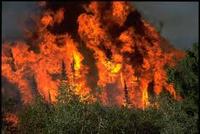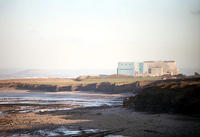-
Engineers to build Australia’s first bushfire resistant straw house
With Australia’s bushfire season fast approaching, construction of the first bushfire resistant straw bale house tested by engineers from CSIRO has begun in rural Victoria; the house is based on design principles that minimize environmental impact and it is set to withstand temperatures equal to that of a worst case bushfire scenario
-
-
Target of limiting global warming to 2°C recedes as CO2 emissions grow
A new report shows that global CO2 emissions have increased by 58 percent since 1990, rising 3 percent in 2011, and 2.6 percent in 2012; the most recent figure is estimated from a 3.3 percent growth in global gross domestic product and a 0.7 percent improvement in the carbon intensity of the economy; these latest carbon dioxide emission figures continue to track at the high end of a range of emission scenarios, expanding the gap between current trends and the course of mitigation needed to keep global warming below 2°C
-
-
Wind and solar power, paired with storage, would be cost-effective way to power grid
Renewable energy could fully power a large electric grid 99.9 percent of the time by 2030 at costs comparable to today’s electricity expenses, new research says; a well-designed combination of wind power, solar power, and storage in batteries and fuel cells would nearly always exceed electricity demands while keeping costs low, the study authors found
-
-
Climate models still struggle with medium- term climate forecasts
Scientists have evaluated twenty-three climate models and concluded that there is still a long way to go before reliable regional predictions can be made on seasonal to decadal time scales; none of the models evaluated is able today to forecast the weather-determining patterns of high and low pressure areas such that the probability of a cold winter or a dry summer can be reliably predicted
-
-
U.S. faces more – and more intense – wildfire

Scientists using NASA satellite data and climate models have projected drier conditions likely will cause increased fire activity across the United States in coming decades; the researchers calculated results for low and high greenhouse gas emissions scenarios; in both cases, results suggest more fire seasons that are longer and stronger across all regions of the United States in the next 30-50 years; specifically, high fire years like 2012 would likely occur two to four times per decade by mid-century, instead of once per decade under current climate conditions
-
-
Geoengineering could disrupt global rainfall patterns
Tackling climate change by reducing the solar radiation reaching our planet using climate engineering, known also as geoengineering, could result in undesirable effects for the Earth and humankind; in particular, new research shows that disruption of global and regional rainfall patterns is likely in a geoengineered climate
-
-
TVA considering raising height of dams to prevent future floods
The dams located on the upper Tennessee River never had flood waters top them, and government officials want to keep it that way, saying that due to recent disasters such as the 2010 Nashville flood and the 2011Fukushima tsunami, they need to prepare the worst possible situation
-
-
Removing sea defenses may reduce impact of coastal flooding
Coastal defenses put in place over the last century or so have re-shaped the U.K. coastline, artificially protecting some areas, but at the expense of beaches in adjacent areas; this man-made situation increases the risk of flooding in low lying coastal settlements where beaches act as a natural flood defense; beach levels can be artificially recharged, but maintaining this indefinitely along large stretches of coastline is costly and likely to be unsustainable
-
-
Pulverized rocks used to strip CO2 from emissions of steel, coal, cement plants
Researchers in Quebec are developing a process which would see steel, coal, and cement plants as well as oil and gas facilities remove most of the carbon dioxide (CO2) from their emissions through chemical reactions with various types of crushed rocks in the stacks
-
-
Critics: post-Fukushima nuclear power may be safer, but it is still not cost effective
The Southern Company wants to show its customers that it has learned from the Fukushima disaster in Japan and has protected its nuclear reactors to make sure the same thing does not happen in the United .States’ critics of nuclear power are not convinced – and also, they say, alternative energy sources, such as natural gas, are much cheaper to produce
-
-
Andrew Cuomo heads to Washington to push for disaster aid
Governor Andrew Cuomo says that New York needs $33 billion to cover storm cleanup and another $9 billion for new programs to protect against future storms; Governor Chris Christie of New Jersey says his state will need $36.8 billion to recover from Sandy; it is not clear how Congress and the administration, locked in a tug of war over differing deficit cut plans, will respond
-
-
Life of U.K. nuclear power plants extended

U.K. operator EDF Energy has announced it will extend the expected operating life of two of its nuclear power stations by seven years; Hinkley Point B and Hunterston B power stations are now expected to remain operational until at least 2023, generating enough electricity for around two million homes; the decision follows the five year extensions to Heysham 1 and Hartlepool announced in 2010 and come after extensive reviews of the plants’ safety cases and continuing work with the independent nuclear regulator
-
-
Responding to future oil spills: lessons learned from Deepwater Horizon
A special collection of articles about the Deepwater Horizon oil spill provides the first comprehensive analysis and synthesis of the science used in the unprecedented response effort by the government, academia, and industry;with the benefit of hindsight and additional analyses, these papers evaluate the accuracy of the information that was used in real-time to inform the response team and the public
-
-
Below Russian Far East there is a seismic hazards that could threaten Pacific Basin
For decades, a source of powerful earthquakes and volcanic activity on the Pacific Rim was shrouded in secrecy, as the Soviet government kept outsiders away from what is now referred to as the Russian Far East; research in the last twenty years, however, has shown that the Kamchatka Peninsula and Kuril Islands are a seismic and volcanic hotbed, with a potential to trigger tsunamis that pose a risk to the rest of the Pacific Basin
-
-
Mixing oil with dispersant increased toxicity to Gulf’s ecosystems
If the 4.9 million barrels of oil that spilled into the Gulf of Mexico during the 2010 Deep Water Horizon spill was an ecological disaster, the two million gallons of dispersant used to clean it up apparently made it even worse – fifty-two-times more toxic
-
- All
- Regional
- Water
- Biometrics
- Borders/Immig
- Business
- Cybersecurity
- Detection
- Disasters
- Government
- Infrastructure
- International
- Public health
- Public Safety
- Communication interoperabillity
- Emergency services
- Emergency medical services
- Fire
- First response
- IEDs
- Law Enforcement
- Law Enforcement Technology
- Military technology
- Nonlethal weapons
- Nuclear weapons
- Personal protection equipment
- Police
- Notification /alert systems
- Situational awareness
- Weapons systems
- Sci-Tech
- Sector Reports
- Surveillance
- Transportation
Advertising & Marketing: advertise@newswirepubs.com
Editorial: editor@newswirepubs.com
General: info@newswirepubs.com
2010-2011 © News Wire Publications, LLC News Wire Publications, LLC
220 Old Country Road | Suite 200 | Mineola | New York | 11501
Permissions and Policies
Editorial: editor@newswirepubs.com
General: info@newswirepubs.com
2010-2011 © News Wire Publications, LLC News Wire Publications, LLC
220 Old Country Road | Suite 200 | Mineola | New York | 11501
Permissions and Policies
